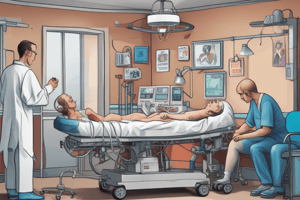Podcast
Questions and Answers
What is the recommended patient position for a cardiorespiratory examination?
What is the recommended patient position for a cardiorespiratory examination?
- Prone position
- Flat on the back
- 45 degrees upright (correct)
- Standing position
In chest examination, what is assessed by observing the patient's level of comfort?
In chest examination, what is assessed by observing the patient's level of comfort?
- Blood pressure
- Muscle strength
- Heart rate
- Breathing pattern (correct)
How is body built defined in a clinical examination?
How is body built defined in a clinical examination?
- Height to span relationship (correct)
- Body mass index (BMI)
- Weight to height ratio
- Muscle mass to fat ratio
What is the Glasgow Coma Scale used to assess in patients?
What is the Glasgow Coma Scale used to assess in patients?
What is one of the signs of vitamin deficiency that can be observed during a chest examination?
What is one of the signs of vitamin deficiency that can be observed during a chest examination?
How is nutrition clinically assessed using anthropometric measurements?
How is nutrition clinically assessed using anthropometric measurements?
What is the normal ratio of the anteroposterior diameter to the transverse diameter of the chest?
What is the normal ratio of the anteroposterior diameter to the transverse diameter of the chest?
Which of the following is NOT a characteristic of a normal chest shape?
Which of the following is NOT a characteristic of a normal chest shape?
Which of the following chest abnormalities is characterized by a depression in the sternum?
Which of the following chest abnormalities is characterized by a depression in the sternum?
What is the normal range for the subcostal angle in a healthy individual?
What is the normal range for the subcostal angle in a healthy individual?
Which of the following techniques is used to assess the respiratory rate while avoiding voluntary changes by the patient?
Which of the following techniques is used to assess the respiratory rate while avoiding voluntary changes by the patient?
Which of the following chest abnormalities is characterized by a protrusion of the sternum?
Which of the following chest abnormalities is characterized by a protrusion of the sternum?
Which of the following observations is NOT a normal finding during examination of the jugular venous pulse (JVP)?
Which of the following observations is NOT a normal finding during examination of the jugular venous pulse (JVP)?
Which of the following findings during lower limb examination is suggestive of peripheral arterial disease?
Which of the following findings during lower limb examination is suggestive of peripheral arterial disease?
Which of the following conditions is NOT a common cause of non-pitting edema?
Which of the following conditions is NOT a common cause of non-pitting edema?
Which of the following findings during lower limb examination is suggestive of deep vein thrombosis (DVT)?
Which of the following findings during lower limb examination is suggestive of deep vein thrombosis (DVT)?
Which of the following statements regarding personal history taking is INCORRECT?
Which of the following statements regarding personal history taking is INCORRECT?
Which of the following statements regarding examination of the thyroid gland is correct?
Which of the following statements regarding examination of the thyroid gland is correct?
Flashcards are hidden until you start studying
Study Notes
General Examination
- Introduce yourself, explain the purpose, obtain consent, wash hands, and position yourself and the patient
- Ensure adequate exposure while maintaining patient privacy
- Observe the patient's general appearance, including:
- Level of consciousness (Glasgow Coma Scale: 3-15)
- Level of comfort (pain, sweating, breathlessness, use of accessory muscles)
- Body build (relationship between height and span according to age, sex, and race)
- Any medical equipment nearby (oxygen cylinders, nebulizers, sputum pots, medicines, intercostal tube)
Nutrition and Anthropometric Measurements
- Measure Body Mass Index (BMI)
- Look for signs of vitamin deficiency
- Evaluate attitude and decubitus (position of the patient in bed)
Chest Examination
- Inspect the chest for:
- Shape (elliptical, symmetrical, AP diameter = 5/7 transverse diameter)
- Respiratory movement (rate, rhythm, depth, type of breathing)
- Pulsation, dilated veins, pigmentation, sinuses, fistula, scars, skin rashes
- Subcostal angle (90 ±20)
- Palpate, percuss, and auscultate the chest
Thyroid Examination
- Examine the thyroid gland for goiter
Lower Limb Examination
- Inspect the nails for clubbing, color, splinter hemorrhage, pitting, etc.
- Examine the skin for rashes, pigmentations, scars
- Check for edema (type, unilateral or bilateral, level, and test for sacral edema in bedridden patients)
- Evaluate peripheral pulsations, tender calves, and diabetic foot
Patient History Taking
- Take a thorough personal history, including:
- Name and surname
- Sex
- Age and occupation
- Marital status
- Residence
- Special habits
Studying That Suits You
Use AI to generate personalized quizzes and flashcards to suit your learning preferences.




